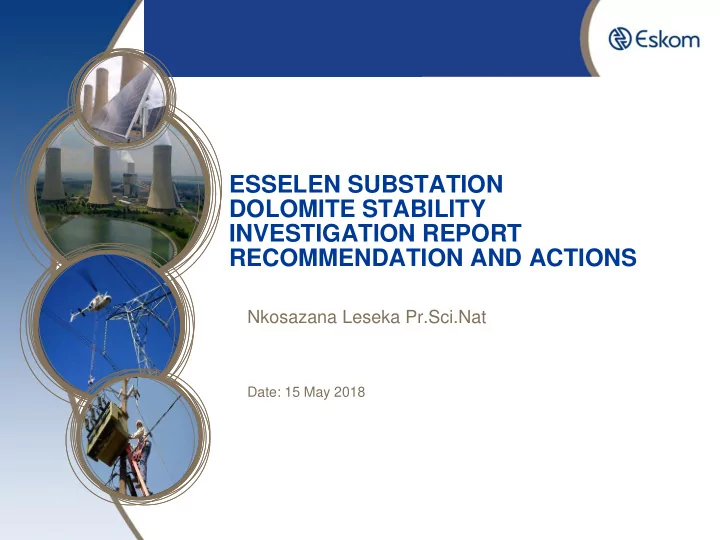

ESSELEN SUBSTATION DOLOMITE STABILITY INVESTIGATION REPORT RECOMMENDATION AND ACTIONS Nkosazana Leseka Pr.Sci.Nat Date: 15 May 2018
Content • Background • Summary of the Esselen Substation DSI report • Recommendations and Actions
BACKGROUND LEADING TO DSI • Esselen Substation has long history of sinkhole manifestations • Record Keeping Strategies? • Efforts of rehabilitation • Successes and Failures • Emergence of new sinkholes, subsidence features, and tension cracks • Unknown extent of hazard associated with Dolomite Instability • Proactive measures to manage hazards • Zonation of site according to defined hazard class • A geoscience consultant was appointed conduct the DSI to address these problems
WORK AREA
OBJECTIVES OF DSI • Assess the exposure and vulnerability of the site to dolomite geo-hazards which have historically manifest into sinkholes and surface subsidence. • Characterize the suitability of the site for any future development • Highlight any discrepancies noted on the site in aspects of geotechnical stability risk • Determination of the site specific geological conditions • Determination of all potentially restraining dolomite stability factors including the hydrogeological characteristics and soils • Establish the presence and proximity of groundwater to the surface including historic groundwater data • Classification of the site according to SANS 1936 in respect of dolomitic land • Provide recommendations for future utilization of the site, risk management solutions
GEOLOGICAL LOCALITY OF ESKOM ESSELEN SUBSTATION • Malmani Subgroup of the Chuniespoort Group Rocks: • Dolomite & Chert • Composition of dolomite rock: • Water + Carbon Dioxide = Carbonic Acid i.e. • Typical Dissolusion Mechanism: • CaMg(CO3)2 + 2 H2CO3 Ca(HCO3)2 + Mg(HCO3)2 540A
CURRENTLY EXISTING Historic Karst Instability SINKHOLE
REGIONAL HYDROGEOLOGY MONITORING STATION: MONITORING STATION: A2N0631 1987 - 2017 A2N0627 1987 - 2017
SITE INVESTIGATIONS • Geophysical Surveys • Test Pits • Borehole Drilling • Rehabilitations • Borehole Logging
Gravity Survey GRAVITY SURVEY SITE TOPOGRAPHY RESULTS
Resistivity Survey NE-SW DIRECTION SE-NW DIRECTION
TEST PITING & BOREHOLE DRILLING
BOREHOLE PROFILING – Two groups of geological profiles • Defined by the gravity high • Defined by gravity low zones zones and higher apparent and low resistivity signature resistivity signature. • The gravity low zones are • Characterized by shallow characterized by deeper dolomite bedrock conditions dolomite bedrock overlain by which vary based on weathered small persistent cavities and soft zones of chert and iron clay, clayey silt overburden in oxides/ferruginous soils and upwards succession cavities..
GEOTECHNICAL FINDINGS • Due to the variable depth to dolomite bedrock, the site is inferred to be more prone to develop medium to large sinkholes respective to the borehole results. Medium sinkholes are sinkholes expected to have a nominal diameter of 2 – 5 m and large sinkhole expected to have 5 – 15 m diameter. • The blanketing material at the site may be summed up as ferrugenised SILTY SAND, SILT and SOFT CLAY with fragments of highly weathered CHERT. • less than 1 minute per meter drilling rate drilled over the blanketing material suggest moderate to highly permeable material susceptible to collapse/movements. • Thus instability triggered by water ingress from the surface is highly likely in situations whereby surface water is not drained at sufficient rate.
GEOTECHNICAL FINDINGS • Groundwater level is assessed to be below the cavity prone dolomite horizons at the site (i.e. >24 from surface). • Drawdown of existing groundwater level would have non to little impact on the stability of the dolomitic land as it is not within highly leached / weathered CHERT and DOLOMITE horizons characterized by cavities. • Precautionary measure to manage the usage/fluctuation of the groundwater particularly focusing on possible rise and fall of the groundwater table that could increase the inherent hazard for ground movement.
GEOTECHNICAL FINDINGS • The vast area on the western flank of the Eskom Esselen Substation has been zoned of as a high risk area as a whole due to evident sinkhole formation within that area. The triggering mechanism for sinkhole formation is by assessment due to sudden loss of support accelerated by surface water ingress.
DOLOMITE LAND CLASSIFICATION • The site falls under C3 type development • Portions of the site are thus regarded to be conditionally developable under D3 + Footprint Investigation conditions as a C3 Development Type • All future developments at the site may only be permitted after satisfaction of footprint investigations (FPI) • Submitted to the CGS for consent prior to any investigation • Certified site development plan should be submitted to the CGS for co-signing
Recommendations and Actions • Re-route the high risk fence, non lethal fence and inner fence as a proposal • Drainage (Concrete Line open drainage especially on the western flank of the station) + Contouring of the entire site to achieve a general slope • fall of least 1:40 in general and to 1:15 away from structures within a distance of 8 m of a structure is required • Once the fence is moved, we may rehabilitate the existing sinkhole, if it impacts the risk within the fence (which will be outside the station parameter fence) • Put up a ground water monitoring station within the substation as per the recommendation
Recommendations and Actions (continuum)… • Contact Ekurhuleni Municipality for the risk management plan • Do a site specific Dolomite Risk Management Plan in accordance to SANS 1936 – 4:2012 • Involve all stakeholders to be part of the workgroup • Have an awareness campaign to inform all stakeholders especially safety and environment as part of the safety talk • If any construction takes place, make the responsible person aware of the risk (through the DRMP) to pro-actively apply sound water management system or procedure • It must form part of the Inspection Test Plan (ITP) of which there must be hold points for inspection.
Thank you Nkosazana Leseka Pr.Sci.Nat Email: lesekana@eskom.co.za
Recommend
More recommend